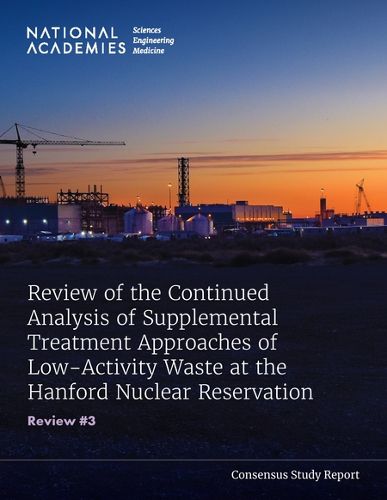Readings Newsletter
Become a Readings Member to make your shopping experience even easier.
Sign in or sign up for free!
You’re not far away from qualifying for FREE standard shipping within Australia
You’ve qualified for FREE standard shipping within Australia
The cart is loading…






The Hanford Nuclear Reservation in the state of Washington produced about two-thirds of the nations plutonium for nuclear weapons from 1944 until the last reactor was shut down in 1987. The U.S. Department of Energy Office of Environmental Management (DOE-EM) manages the ongoing clean-up at Hanford and has built a plant to convert the high-level radioactive waste into a glass form (vitrification) for safe disposal. However, decisions remain about how best to treat and dispose of the low-level waste at Hanford, which comprises over 90% of the volume of waste. To inform its decision, DOE contracted with key Federally Funded Research and Development Centers (FFRDC), led by Savannah River National Laboratory, to carry out an analysis. This final in a trilogy of reports from the National Academies reviews the FFRDC third report released in January 2023.
The review finds that the FFRDC team made a strong technical case that converting the supplemental low-level waste from the vitrification process to a grout form (like cement) is the best option in terms of cost-effectiveness and timeliness, and that off-site disposal of that grout is a valid option as it will be away from potable water. The FFRDC provided a useful framework to help decision-makers understand the issues and trade-offs of the disposal options and did an excellent job of isolating specific factual considerations that can be analyzed, often quantified, and compared with each other. The FFRDC chose to provide a purely technical analysis that excluded analysis of two important factors to be considered - securing regulatory permissions and public acceptance - treating them, for now, as uncertainties. Looking ahead, the DOE faces many uncertainties and should emphasize flexibility in its overall approach, allowing for multiple, redundant options and pathways, as well as the ability to change over time.
Table of Contents
Front Matter Summary 1 Context and Setting 2 Statement of Task 3 Report Strengths 4 Report Limitations References Appendix A: Section 3125 of Fiscal Year 2021 National Defense Authorization Act and Section 3134 of Fiscal Year 2017 National Defense Authorization Act Appendix B: Statement of Task Appendix C: Public Meeting Agendas Appendix D: Findings and Recommendations from "Review of the Continued Analysis of the Supplemental Treatment Approaches of Low-Activity Waste at the Hanford Nuclear Reservation: Review #1" Appendix E: Findings and Recommendations from "Review of the Continued Analysis of Supplemental Treatment Approaches of Low-Activity Waste at the Hanford Nuclear Reservation: Review #2" Appendix F: FFRDC Response to National Academy of Sciences Recommendations for "Review of the Continued Analysis of Supplemental Treatment Approaches of Low-Activity Waste at the Hanford Nuclear Reservation: Review #2" Appendix G: Acronyms and Abbreviations Appendix H: Committee, Consultant, and Staff Biographies
$9.00 standard shipping within Australia
FREE standard shipping within Australia for orders over $100.00
Express & International shipping calculated at checkout
The Hanford Nuclear Reservation in the state of Washington produced about two-thirds of the nations plutonium for nuclear weapons from 1944 until the last reactor was shut down in 1987. The U.S. Department of Energy Office of Environmental Management (DOE-EM) manages the ongoing clean-up at Hanford and has built a plant to convert the high-level radioactive waste into a glass form (vitrification) for safe disposal. However, decisions remain about how best to treat and dispose of the low-level waste at Hanford, which comprises over 90% of the volume of waste. To inform its decision, DOE contracted with key Federally Funded Research and Development Centers (FFRDC), led by Savannah River National Laboratory, to carry out an analysis. This final in a trilogy of reports from the National Academies reviews the FFRDC third report released in January 2023.
The review finds that the FFRDC team made a strong technical case that converting the supplemental low-level waste from the vitrification process to a grout form (like cement) is the best option in terms of cost-effectiveness and timeliness, and that off-site disposal of that grout is a valid option as it will be away from potable water. The FFRDC provided a useful framework to help decision-makers understand the issues and trade-offs of the disposal options and did an excellent job of isolating specific factual considerations that can be analyzed, often quantified, and compared with each other. The FFRDC chose to provide a purely technical analysis that excluded analysis of two important factors to be considered - securing regulatory permissions and public acceptance - treating them, for now, as uncertainties. Looking ahead, the DOE faces many uncertainties and should emphasize flexibility in its overall approach, allowing for multiple, redundant options and pathways, as well as the ability to change over time.
Table of Contents
Front Matter Summary 1 Context and Setting 2 Statement of Task 3 Report Strengths 4 Report Limitations References Appendix A: Section 3125 of Fiscal Year 2021 National Defense Authorization Act and Section 3134 of Fiscal Year 2017 National Defense Authorization Act Appendix B: Statement of Task Appendix C: Public Meeting Agendas Appendix D: Findings and Recommendations from "Review of the Continued Analysis of the Supplemental Treatment Approaches of Low-Activity Waste at the Hanford Nuclear Reservation: Review #1" Appendix E: Findings and Recommendations from "Review of the Continued Analysis of Supplemental Treatment Approaches of Low-Activity Waste at the Hanford Nuclear Reservation: Review #2" Appendix F: FFRDC Response to National Academy of Sciences Recommendations for "Review of the Continued Analysis of Supplemental Treatment Approaches of Low-Activity Waste at the Hanford Nuclear Reservation: Review #2" Appendix G: Acronyms and Abbreviations Appendix H: Committee, Consultant, and Staff Biographies